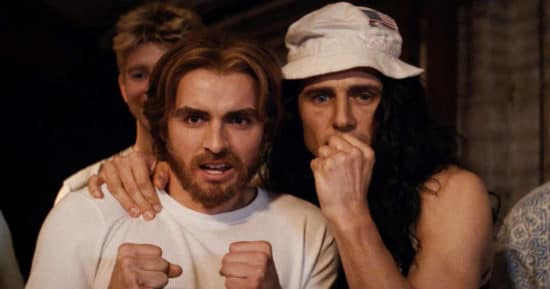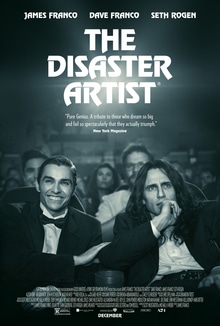 Follow your dreams. It’s arguably the one message Hollywood has sold us most consistently over the decades. Passion, determination and perseverance will ultimately pay off, they say, so long as you’re true to yourself and stay strong in the face of adversity. Alas, as years of singing-based TV talent shows have so sadistically emphasised, ambition and willpower don’t always go hand-in-hand with self-awareness and actual ability. Sure, you can put yourself out there for all to see, step out before an audience and/or a camera with your heart worn proudly on your sleeve, and give it all you’ve got; but this doesn’t guarantee anyone’s going to like it, or that it’ll actually be any good.
Follow your dreams. It’s arguably the one message Hollywood has sold us most consistently over the decades. Passion, determination and perseverance will ultimately pay off, they say, so long as you’re true to yourself and stay strong in the face of adversity. Alas, as years of singing-based TV talent shows have so sadistically emphasised, ambition and willpower don’t always go hand-in-hand with self-awareness and actual ability. Sure, you can put yourself out there for all to see, step out before an audience and/or a camera with your heart worn proudly on your sleeve, and give it all you’ve got; but this doesn’t guarantee anyone’s going to like it, or that it’ll actually be any good.
This, essentially, is the legend of actor, writer, producer and director Tommy Wiseau. It’s strange to think that his debut feature The Room isn’t even 15 years old yet, as its reputation as the most magnificently awful film ever made feels like a tale of the ages. Indeed, it’s proved legendary enough to become the basis of a major production from a number of the biggest stars currently working in Hollywood, with James Franco following Wiseau’s lead as the film’s director, producer and star (although he didn’t write the script, nor does he even take top billing, chivalrously giving that honour to his younger brother Dave).
 The younger, top-billed Franco is Greg Sestero, a young San Franciscan model-turned-actor, struggling to find his feet as he suffers stage fright. However, one night at acting class he witnesses fellow student Tommy (Franco the elder) – an enigmatic loner with a flamboyant quasi-Goth dress sense and an unplaceable accent – give a wildly unrestrained take on a few words from A Streetcar Named Desire. Impressed, Greg approaches Tommy for advice on how to emote, and a slightly awkward friendship ensues; Tommy seems happy to take Greg under his wing, but is unwilling to reveal much about himself or his past. This proves challenging, as so much about Tommy begs questions: where is this anonymous oddball actually from, how old is he, and how does he have seemingly inexhaustible supplies of money?
The younger, top-billed Franco is Greg Sestero, a young San Franciscan model-turned-actor, struggling to find his feet as he suffers stage fright. However, one night at acting class he witnesses fellow student Tommy (Franco the elder) – an enigmatic loner with a flamboyant quasi-Goth dress sense and an unplaceable accent – give a wildly unrestrained take on a few words from A Streetcar Named Desire. Impressed, Greg approaches Tommy for advice on how to emote, and a slightly awkward friendship ensues; Tommy seems happy to take Greg under his wing, but is unwilling to reveal much about himself or his past. This proves challenging, as so much about Tommy begs questions: where is this anonymous oddball actually from, how old is he, and how does he have seemingly inexhaustible supplies of money?
On a whim, the duo move to Los Angeles, hellbent on pursuing their shared goal of stardom. When finding work proves harder than they’d hoped, Greg suggests they just make a movie of their own. Hit by sudden inspiration, Tommy writes a script which he calls The Room, a character-based drama tackling, as he sees it, major themes of human nature, trust and betrayal. Thanks to the vast swathes of cash at his disposal, Tommy entirely self-finances the project, casts himself and Greg in the lead roles, and the two assemble a cast and crew for a production which, for better or worse, will prove a singular experience for all involved: for, while Tommy may have the funds and the passion, it quickly becomes clear he doesn’t have the first clue how to make a movie.
The cult status surrounding The Room can prove alienating and bewildering to those on the outside of it; this I know first hand, as I only just saw The Room for the first time just last week, in preparation for this. Having seen the film, and been duly intrigued/appalled/amused, I can understand why it has become a midnight movie favourite, thanks to its laugh out loud its absurdity; how high it reaches, and how spectacularly it fails in every department. So the question is, what are Franco and co aiming to achieve by retelling the story (already documented in Sestero’s memoir, also entitled The Disaster Artist)? Is it a cautionary tale, warning the ambitious to avoid the same Icarus-esque trajectory as Wiseau; or are we meant to identify some redeeming qualities in Wiseau, and admire his single-minded determination?
The answer, I suppose, is somewhere in the middle, and it does make for a slightly odd brew. There are naturally heavy streaks of smug hipster humour surging through The Disaster Artist, a sense of an in-joke which only the cool people get; this is perhaps exacerbated by an odd, largely gratuitous prologue montage featuring a bunch of high-profile Hollywood people, plus Kevin Smith (BURN), talking about their love for The Room. I had worried going in that the amount of celebrity casting in the film might also prove distracting, but refreshingly it doesn’t: supporting turns from Seth Rogen, Zac Efron and Josh Hutcherson are nicely underplayed, whilst cameos from Sharon Stone and Melanie Griffith are blink-and-you’ll-miss-it.
The real heart of the story is the friendship between Wiseau and Sestero. Yes, in common with most of the other works of James Franco, Seth Rogen and Evan Goldberg (who also co-produce), The Disaster Artist is ultimately a bromantic comedy – quite literally so in this instance, given it’s the Franco brothers – and, when one might assume things would get cynical, there’s a surprising sincerity to it all, amplified by the excess of reverb-heavy guitar in the emotional bits, and Dave Franco’s grounded, good-natured take on Sestero; a simple performance, but that’s what the material calls for.
 Which brings us to the matter of James Franco, and his performance as Wiseau. It’s not hard to see why any high-profile actor would want to take on such a role: he’s a fascinating, bizarre character, and the cult status of The Room almost certainly owes more to his performance than anything else. Watching The Disaster Artist, it may leave one half surprised that Johnny Depp didn’t get in there before Franco, given the opportunity to put on a wig and some prosthetic make-up, and talk in a funny accent. The curious thing is, whilst the wig, make-up, contact lenses and of course the voice may render Franco almost unrecognisable, they don’t make him a picture-perfect facsimile of Wiseau either. In a strange way, the overall effect is reminiscent of Will Smith in Ali; rather than striving for the most accurate impersonation possible of the real person, Franco simply plays Wiseau as a character, hitting similar notes and evoking similar mannerisms, but really doing his own thing with it. Whether or not this is a problem may depend on the viewer’s familiarity with The Room, but it’s fair to assume that even those unfamiliar with the source material will still be able to watch and enjoy The Disaster Artist just fine; much as was the case with Tim Burton’s Ed Wood, the film’s most obvious kindred spirit.
Which brings us to the matter of James Franco, and his performance as Wiseau. It’s not hard to see why any high-profile actor would want to take on such a role: he’s a fascinating, bizarre character, and the cult status of The Room almost certainly owes more to his performance than anything else. Watching The Disaster Artist, it may leave one half surprised that Johnny Depp didn’t get in there before Franco, given the opportunity to put on a wig and some prosthetic make-up, and talk in a funny accent. The curious thing is, whilst the wig, make-up, contact lenses and of course the voice may render Franco almost unrecognisable, they don’t make him a picture-perfect facsimile of Wiseau either. In a strange way, the overall effect is reminiscent of Will Smith in Ali; rather than striving for the most accurate impersonation possible of the real person, Franco simply plays Wiseau as a character, hitting similar notes and evoking similar mannerisms, but really doing his own thing with it. Whether or not this is a problem may depend on the viewer’s familiarity with The Room, but it’s fair to assume that even those unfamiliar with the source material will still be able to watch and enjoy The Disaster Artist just fine; much as was the case with Tim Burton’s Ed Wood, the film’s most obvious kindred spirit.
The Disaster Artist has more than a hint of awards season buzz around it right now, and there would no doubt be a certain snake-eating-its-own-tail poetry to it cleaning up at the Oscars (and/or all the other awards shows that very few people really care about); but personally, I can’t see it happening. Franco has certainly crafted an engrossing, entertaining film that deserves to be seen and praised, but once we get beyond the colourful subject matter, it’s hard to shake the feeling that this is ultimately a fairly standard triumph of the underdog story; and we might question whether its triumphant tone is entirely warranted, given The Room’s legacy.
That having been said, while the victorious ending may feel just a little off, there is perhaps a valuable message therein. Wiseau, though naturally heartbroken by the audience’s laughter at first, learns to embrace it: sure, it isn’t the response he hoped for, but it’s a strong and ultimately positive response nonetheless. I daresay a lot of artists would do well to follow this example. The creator’s vision is all well and good, but it may not necessarily fall in line with the audience’s reaction, and at the end of the day they are the ones who decide what the work is worth. This, I think, is the key thing The Disaster Artist has to say, and it’s a worthwhile lesson.
And on that note – I don’t care what you say, James Franco, I thought Your Highness was brilliant.
The Disaster Artist is in cinemas now.
